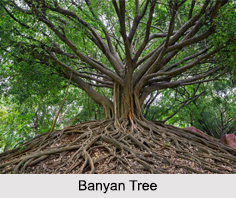 Banyan Tree is a very popular tree of the country. It is one of those trees, which have wide branches and are very much able of giving shade. Banyan tree grows widely in all parts of the country. The origin of the banyan tree is mainly in south and west India and in the sub-Himalayan tracts. It is widely planted throughout the country and elsewhere in tropical Asia in gardens and along roads for shade. In fact, a banyan tree is such a wide tree that people of an entire village will be able to settle under it.
Banyan Tree is a very popular tree of the country. It is one of those trees, which have wide branches and are very much able of giving shade. Banyan tree grows widely in all parts of the country. The origin of the banyan tree is mainly in south and west India and in the sub-Himalayan tracts. It is widely planted throughout the country and elsewhere in tropical Asia in gardens and along roads for shade. In fact, a banyan tree is such a wide tree that people of an entire village will be able to settle under it.
Etymology of Banyan Tree
The biological name of banyan tree is "Ficus Benghalensists". This tree belongs to "Moraceae" family. It is known by different names in different parts of the country. The Hindi speaking people call it "Bargad", "Bor" or "Ber". It is known as "Ala" in Tamil, "Petal" in Malayalam and "Mart" or "Pedda-mari" in Telugu. In Hinduism, the banyan tree is considered sacred.
Description of Banyan Tree
The banyan tree is an excellent example of what is called an epiphytic growth. The bark is grey in colour and soft also spotted generally as it flakes off very easily. In the grown-up trees, the trunk is a composition of several complex aerial roots. Some clumps of brown rope hang from every branch. These ropes ultimately get united and after reaching the ground, they take the root and grow into separate trunks. For this reason only, the tree widens and covers an ever-increasing area. The leaves of the banyan tree are large in size and leathery. They are mostly oval-shaped and dark and shiny green in colour. They are pale-veined. Though there are no flowers in the banyan tree, yet it bears some fruits.
Uses of Banyan Tree
The aerial roots provide stronger timber and people use them in making tent-poles. A coarse fibre can be obtained from the bark and young hanging roots, and can be used for making ropes. From the sticky, milky sap, people can make Birdlime and it poses some medicinal properties as well. Not only are these, the leaves of the tree are also used as plates.
Medicinal Uses of Banyan Tree
Banyan tree is known for its extensive medicinal properties and uses. The stem bark, root bark, aerial roots, leaves, vegetative buds and milky exudates are all used in Ayurvedic medicine. Further, the crushed seeds and the milky juice exuded from the cut stems, branches and twigs are applied externally to relieve pains, sores, ulcers and bruises, and as an anodyne for treating rheumatism and lumbago. It is considered a valuable application for relieving and healing cracked and burning soles, and is also used as a remedy for toothache. The crushed dried fruits of banyan tree are taken with honey as a treatment for spermatorrhoea among the tribes of central Odisha; in this region the latex of the plant is taken with banana in the treatment of gonorrhoea.
The seeds are considered cooling and tonic. A paste of the leaves, or the heated leaves, is applied as a poultice to promote healing of abscesses. An extract of the leaves is used as an aphrodisiac by the people in north-eastern Karnataka. The bark is astringent; its infusion is considered a powerful tonic and useful for treating diabetes, dysentery and diarrhoea, leucorrhoea, menorrhagia and nervous disorders. An infusion of the young buds is considered useful for diarrhoea and dysentery. The young tips of the aerial (hanging) roots are given as an anti-emetic; crushed and boiled in cow"s milk; the hot filtered solution is taken to relieve piles among the tribal inhabitants of Sundargarh District in Odisha. The aerial root tips are also applied as a paste to relieve bleeding piles and to promote healing of syphilitic lesions among the Kondh Tribe of south-western Odisha, and mixed with egg as an external application to promote healing of bone fractures among the Gond tribe of Uttar Pradesh.











